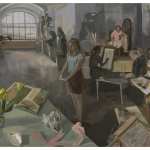
Contributed by Sharon Butler / At artist-run galleries, the conversation centers on art rather than commerce. Alternative spaces provide a place for unknown and under-recognized artists to mount exhibitions, for curators to organize their first thematic shows, and for established artists to present experimental projects that their commercial galleries aren’t interested in showing. “Inventing Downtown,” an ambitious and densely hung group show at the NYU Grey Art Gallery, is full of outstanding work from the artist-run gallery scene in 1950s and 1960s New York City. Some of the artists who showed at the galleries, such as Robert Morris, Alex Katz, and Louise Bourgeois, went on the have big careers, and others, whose work was vital to the conversation at the time, are virtually unknown today.

The show features fourteen galleries that embraced a wide range of programming, from abstract painting and sculpture to performance and video. The exhibition is organized into five thematic groupings. According to the press release:
“Leaving Midtown” focuses on three Tenth Street galleries which adopted a cooperative business structure where expenses were shared among elected members:�Tanager Gallery,�Hansa Gallery, and�Brata Gallery.
“City as Muse” features four ventures that did not adopt the co-op model:�City Gallery,�Reuben Gallery, �Delancey Street Museum, and�Judson Gallery. They are best known for creating dynamic installations and pioneering performances.
“Space and Time” investigates two significant artist-run projects,�112 Chambers Street�and�79 Park Place, which occupied different conceptual terrains, embraced a wide range of media, and shared an interest in exploring temporality and geo-spatial dimensions.
“Politics as Practice” includes four groups: March Group, Judson Church�s Hall of Issues, The Center, and Spiral Group, which examined the viability of politics as a subject for art and channeled a new sense of social urgency in addressing Cold War politics, the civil rights movement, and the legacy of World War II, among other concerns.
“Defining Downtown” looks at the Green Gallery, which played a decisive role in bringing downtown uptown and fostering the rise of Pop and Minimalism. Its program, however, resulted in the narrowing of aesthetic possibilities and the marginalization of many artists.






Every artist’s career has its own own trajectory, and this show proves that building and sustaining a creative life isn’t easy. Imagine a show, curated in 50 years by a curious young academic, that includes work by artists who are working in neighborhoods like Bushwick today. This show is a reminder that many will ultimately leave the city. They may lose their studios to gentrification, realize that rents are too high, miss their hometowns, get academic jobs far away, or, for whatever reason, decide that life is just too damn hard in New York. Now, however, social media makes it possible to stay connected–leaving the city no longer means quitting the art community.
“Inventing Downtown” has a lot of surprising work. In his fine NYTimes review, Holland Cotter writes that the show is “a view of typical � rather than outstanding � art, of familiar artists looking unfamiliar, and of strangers you�re glad to meet.” Don’t miss it.
“Inventing Downtown: Artist-Run Galleries in New York City, 1952�1965,” curated by Melissa Rachleff. Grey Art Gallery, NUY, Greenwich Village, New York, NY. Through April 1, 2017
Related posts:
Adam Tamsky�s American art
Pop abstraction: Nicholas Krushenick at the Tang
Happy Birthday, Alex Katz















Very interesting discussion of this exhibition. I intend to see it. Thank you
Please post Linkedin ‘comment’ to this ‘post’.
Thank You.
T. Michael Stephens writes on LinkedIN: Your “History: Artist-run galleries in NYC” just misses (1966-’72) one of most important: The ANONIMA Studio GALLERY 20 W 40th (top floor) of ANONIMA Group painters Ernst Benkert, Frank (also Karen) Hewitt and Ed Mieczkowski sponsored not only the Group’s Shows but also Forums/Symposia with Ad Rhienhardt, Donald Judd, Rudolph Arnheim, et al.. and Guest Shows/Presentations of Art Research Center Group, Joseph Kosuth, et al.. always with notable historic visitors/admirers Andreas & Eva Wieninger, Johannes Beckmann (all Bauhausers), Sybil Moholy-Nagy, et al… ANONIMA became important from RESPONSIVE EYE forward; influencing another generation, or 2, with Painting Program of Abstract/Geometric “Re-Education of Vision” which continues to shine in new Museums/Collections like MACBA/Buenos Aires ; and, recent works by Benkert and “Constructivist Grit” paintings, constructs of Edwin Mieczkowski.
Thanks for these magnificient images! Not on the NYU Grey website.
Tough work; an inspiration for our times. Artists aren’t alone in being distracted by the new administration of child brats; we are being hijacked by thieves and incompetents . I suggest putting aside a certain amount of time for drawing cartoons of allegorical or mythical personas, enabling us to vent our anger rather than wading through hours of social media…..
I have a water color painting by Guild. On the back it has a number and new York gallery. It was given to me by my great aunt, who got it around 1950. Need help.
Looking for info on a Livingston Galleries on 832 Lexington Avenue between 63rd and 64th Streets. Any help would be appreciated.
I too am looking for info on Livingston Galleries in Manhattan. 832 Lexington Avenue. Thanks for your help!!
Looking for information on Bert Warter (aka . Coral Gaynes) she was watercolor artist and had Bert Warter Studio that was located @200 West 54th street New York 1920-1960 maybe . Not sure if dates